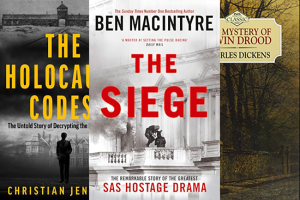
The Siege by Ben Macintyre
Review by John Davis
Ben Macintyre has established a notable reputation in recent years as both an author and a documentary maker specialising in the circumstances and characters involved in real life events.
Among his titles are The Napolean of Crime, Agent Sonya, Colditz, Operation Mincemeat and SAS Rogue Heroes—a second series of which has recently been dramatized on television.
The Siege focuses on an event which occurred during May, 1980 inside and around the Iranian embassy in London’s Prince’s Gate where a small group of activists burst into the building and took twenty-six hostages at gun-point, one of them a Metropolitan Police Officer, Trevor Lock.
Throughout the six days of the impasse, negotiators tried to find a satisfactory way-out for everyone involved including the armed raiders who were incensed by the way the people of their region in Iran had been treated by the regime there.
In the end, no agreement could be negotiated, the British government, with the resolute Margaret Thatcher at the helm, would not give way and an SAS task-force stormed the building-all in front of television cameras broadcasting live.
For those with longer memories, the outcome of the siege will be known but that does not detract from the way in which Macintyre’s comprehensive yet pulsating writing style moves events along at pace.
The thorough author/journalist that he is, Macintyre makes full use of never-before-seen files, and as much information as he can obtain on the actions of both the CIA and MI5. The tale also explores the complex, threaded sub-plots highlighting the bonding and mood swings that developed among hostages and terrorists in such a claustrophobic atmosphere.
Note: The recent film Six Days, directed by Toa Fraser and featuring Jamie Bell and Mark Strong, is an accurate re-telling of the events.
The Holocaust Codes by Christian Jenkins
Review by John Davis
This is the true story of two men who would never meet. They were totally diametric in background, worked thousands of kilometres apart and had very contrasting characteristics yet were to become implacable enemies during the Second World War.
In Nazi occupied Poland there is Austrian-born SS Major Hermann Hofle, a ruthless career bureaucrat terrified that his record keeping and communication skills, although meticulous, will not satisfy the SS hierarchy.
At Bletchley Park, England is the legendary but unsung codebreaker par excellence, Nigel de Grey, a single-minded introvert who was so shy that his colleagues nicknamed him The Dormouse.
Hofle is overseeing the operations of five concentration camps in Poland including Treblinka and is tasked with relaying coded messages back to Berlin with full details about the extent of The Holocaust. De Grey and his colleagues have to decipher the codes being used even though they are subtly changed frequently, sometimes every week.
Such is his determination, de Grey, who co-operates with codebreakers and agents in France, America and the Soviet Union, is also hell-bent on ensuring that somewhat sceptical British government officials are full conversant with the way in which the Holocaust is mushrooming even though the tide has turned against Nazi Germany.
This is a fascinating and thoroughly researched read that unlocks details about an aspect of the tragic consequences of The Holocaust that has received little attention to date. Sources are painstakingly referenced and there is a select bibliography.
Christian Jennings is an authoritative author who has written several books about German cryptanalysis and lectured at Bletchley Park. For some time, he also worked as a foreign correspondent in both The Balkans and Africa.
The Mystery of Edwin Drood by Charles Dickens
Review by John Davis
Antoni Gaudi had his cathedral, Franz Schubert his eighth symphony, Paul Cezanne his Turning Road while for Charles Dickens it was The Mystery of Edwin Drood.
What do all these creative works have in common? It is the fact that they were all left uncompleted when the architect, the composer, the artist and the author died.
Like many of his novels, Dickens’ The Mystery of Edwin Drood was not originally published in book form. It was serialised in a weekly magazine called Every Saturday to keep the reader on tenterhooks. When he died in June 1870, three episodes of the Drood story had been published and three were ready for publication. There were, though, six remaining, with Dickens leaving few notes and no certain intentions about how the mystery of the title would unravel.
In brief, the novel, despite the title, really focuses on Drood’s uncle, John Jasper, a precentor, choirmaster and opium addict in the fictional town of Cloisterham, a thinly disguised version of Rochester in Kent. Jasper has designs on Drood’s fiancée Rosa Bud who has also caught the attention of the headstrong Neville Landless. Landless and Drood take an instant dislike to each other. Later as the story develops, Drood disappears under mysterious circumstances.
No body is discovered so investigations into the disappearance are hampered although, like all good mysteries, there are a number of characters who might have had good cause to want Edwin Drood dead.
Having read the first part of the story, the reader is faced with two main choices. Make up their own mind about what might have happened and who, if anyone, the guilty party might be. Or find a version that has been completed by another writer. Some suggestions for this second course are given below.
Note: Shortly after Dickens’ death Robert Newell completed the novel in 1870. Leon Garfield penned a version in 1980 as did David Madden in 2012, the 100th anniversary of Dickens’ birth. Also, in 2012 there was a television adaptation by Gwyneth Hughes.



